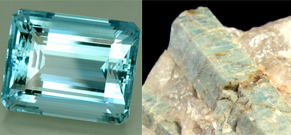 Photo of Aquamarine in Processed & Rough Form
Photo of Aquamarine in Processed & Rough Form
Aquamarine is a mineral with a hardness of 8 out of 10 on the Mohs scale of mineral hardness [?]. These Hexagonally structured gems are made of beryllium aluminum silicate, their full chemical compound being Be3Al2(SiO3)6.
Aquamarine is a form Beryl that is similar in color to sea water. So it varies from green to blue just like the oceans. Most if not all Aquamarine has been heat treated to improve or lighten the color.
Currently the most popular and therefore valuable colors of Aquamarine Beryl are the light "sky" blue versions. If Aquamarine receives large amounts of heat treatment it will bleach or become nearly colorless.
Aquamarine is a wonderful stone to make gems from for many reasons. 1.) Its hard at an 8 out 10 on the Mohs scale. This means it will cut and hold its facet edges well, and they will not easily round off or smooth out. 2.) Aquamarine Beryl is readily found in large deposits of several carats at a time, and these are often free from inclusions (internal flaws). Because of its large availability this gem is usually very affordable.
All in all Aquamarine is a great choice for collectors and investors alike, and will most likely continue to be a popular choice among gem fanatics.
This gem can be found in Russia, Brazil, the United States, Afghanistan, Pakistan, and India.
Looking for a birthstone? Born in March? Aquamarine is often used as your Birthstone.
Why are Brazilian Aquamarines considered the best?
Brazilian deposits, particularly from Minas Gerais, produce crystals with exceptional clarity and the prized deep blue color. These stones typically show better color saturation and larger clean crystals than other sources. Historic Brazilian specimens have set quality standards.
Does Aquamarine really change color over time?
Natural aquamarine often has a blue-green color that's typically heated to create a purer blue. This treatment is permanent. While the stone won't fade, prolonged sun exposure should still be avoided. Any apparent color change usually indicates the stone needs cleaning.
Why are larger Aquamarines relatively affordable?
Unlike many gems, aquamarine commonly forms in large, clean crystals. This means larger stones don't command exponential price increases like diamonds or emeralds. However, stones with deep color in large sizes remain valuable.
Is Santa Maria color worth the premium?
Santa Maria aquamarines, named after the Brazilian mine, show an intense deep blue color that commands premium prices. This rare color grade is considered the finest, especially in larger stones. Modern equivalents are called Santa Maria Africana.
Can Cat's Eye Aquamarine be natural?
Natural cat's eye aquamarine exists but is extremely rare. The chatoyancy effect comes from parallel tube-like inclusions. These specimens are highly valued by collectors, especially with strong eye effect and good color.
What causes the 'bubbles' in my Aquamarine?
Three-phase inclusions (liquid, gas, and crystal) are characteristic of natural aquamarine. These internal features, often called 'fingerprints,' help gemologists identify natural stones and their origin.
Why do some Aquamarines look almost white?
Very pale aquamarines, sometimes called "white aquamarine," have minimal iron content. While these stones are genuine, they're less valued than deeper colored specimens. Most commercial aquamarine is heated to improve pale colors.
The specific gravity [?] for Aquamarine is 2.69, its refractive index [?] is 1.57-1.58, and its double refraction [?] is 0.006.
History
Legend says that Beryl can be used to ward of evil spirits, heal eye injuries, and maintain youthfulness.
This gem has been used for thousands of years in jewelry and trade.
Industrial Usages
Large quantities of Beryl are mined and used to create the Beryllium Metal Alloys.





